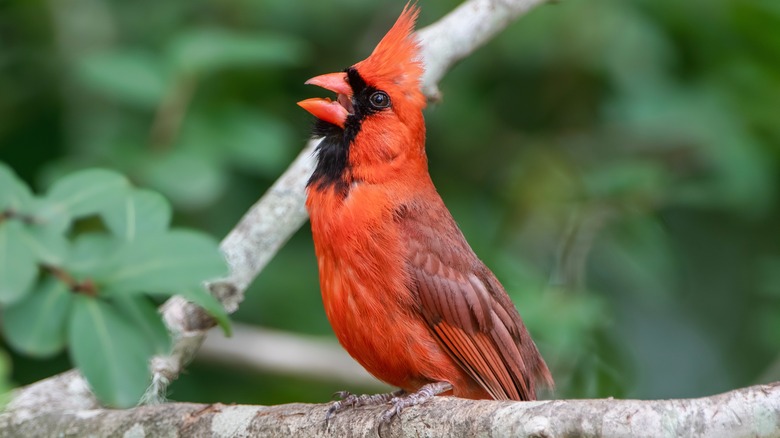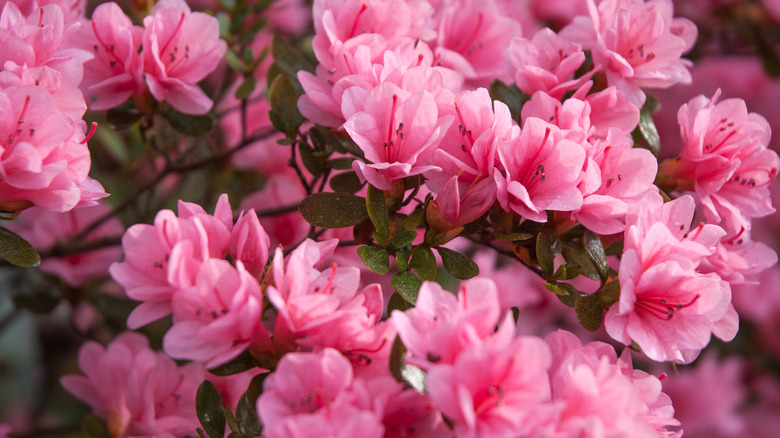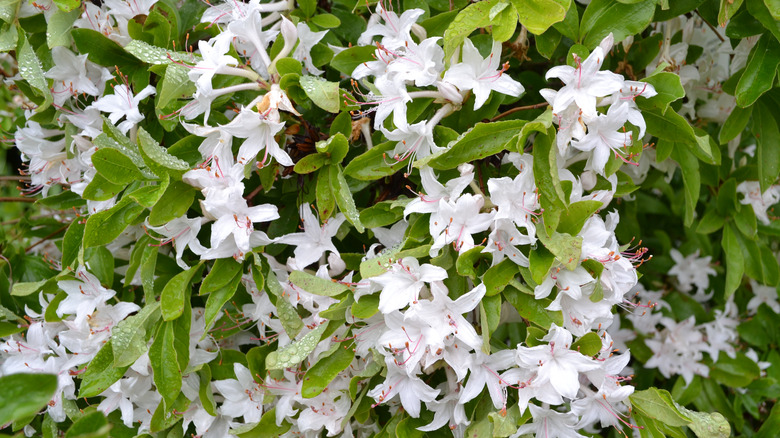Add Color To Your Garden With A Sweet Flower Hummingbirds And Cardinals Love
If birds were ranked like celebrities, hummingbirds and cardinals would definitely make the A-list. They're beloved by backyard birders and regularly grace the covers of wildlife magazines and Christmas cards. While both cardinals and hummingbirds are feeder staples, you can increase your chances of a celebrity sighting by planting flowering shrubs like azaleas.
Azaleas are a garden favorite in many parts of the U.S. They produce a variety of vivid flower colors, and they thrive in a wide range of climates. With more than hundreds of official species and thousands more cultivated varieties, you're sure to find some type of azalea you can grow in your garden. Most azalea bushes grow between 3 to 6 feet tall, but some can reach heights of 15 feet or more. Azaleas are divided into two basic groups: Deciduous azaleas are native to the eastern and southern regions of the U.S., while evergreen azaleas originated in east Asia. Because their leaves stay green year-round, evergreen azaleas are the more popular choice for gardens. But there are benefits to planting deciduous species, especially if you want to attract more hummingbirds and cardinals to your garden.
Why hummingbirds and cardinals love azaleas
More than a dozen species of hummingbirds spend their spring and summer vacations in the U.S. While they're in town, they like to hit up local flowers and feeders to sip as much sugary nectar as they can stomach — and azaleas are one of their favorite stops. Although red, pink, and orange flowers are easy for hummers to spot, research suggests they will visit flowers of any color or shape as long as there is nectar to be had. Fortunately, azaleas have a wide assortment of bloom colors — from white to bright red — and many varieties have trumpet-shaped flowers that hummingbirds find appealing. However, these diminutive diners require more than sugary snacks to meet their nutritional needs. Nearly 80% of their diet comes from insects and spiders. Since azaleas attract aphids, lace bugs, mealybugs, leafhoppers, mites, and a variety of other insects, these plants provide a virtual buffet.
Like hummers, cardinals also benefit from the insects that frequent azaleas. Although they prefer to feed on seeds, they also eat bugs, berries, and the occasional centipede or snail. But insects are the main menu items for nestlings due to their high protein content. Caterpillars are especially prized delicacies, which is great news if your azaleas are invaded by azalea caterpillars (Datana major). Since cardinals prefer to nest in dense bushes or low trees 3 to 10 feet above the ground, some larger and fuller azalea shrubs also make good nesting spots for these birds.
How to plant azaleas to attract hummingbirds and cardinals
To keep hummingbirds sticking around throughout the spring and summer, plant a mix of azalea varieties that bloom at different times. If you're hoping to welcome nesting cardinals, you'll also want to look for taller azalea shrubs with dense foliage. The American Rhododendron Society maintains a searchable database that can help you identify azaleas based on flower color, bloom time, plant height, and other parameters.
While many gardeners opt for evergreen azaleas, there are advantages to planting native deciduous species. For one, research suggests that diverse assemblages of native plants result in more frequent hummingbird visits. Another advantage to native azaleas is that many species bloom later in spring and summer. Sweet azaleas (Rhododendron arborescens) and swamp azaleas (Rhododendron viscosum) are endemic to many eastern states and are a source of food for ruby-throated hummers. However, swamp azaleas have denser foliage, making them a better choice for attracting nesting cardinals.
If you're looking for an all-around evergreen azalea that will attract both cardinals and hummingbirds to your garden, Encore azaleas are a popular choice. These hybrid species have been specifically cultivated to bloom three times per year — spring, summer, and fall. Encores come in many different varieties with a wide range of bloom colors that will please hummingbirds. Most varieties are also dense enough to house cardinal nests. Regardless of the variety you choose, azaleas can turn your yard into a trendy hotspot for A-list avians.



